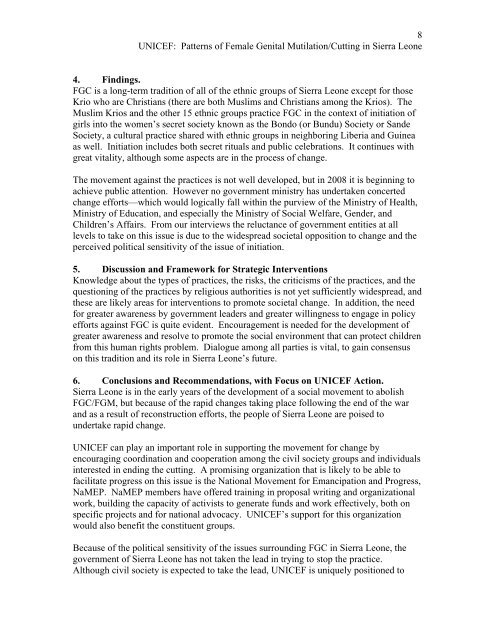Patterns of Female Genital Cutting in Sierra Leone - Unicef
Patterns of Female Genital Cutting in Sierra Leone - Unicef
Patterns of Female Genital Cutting in Sierra Leone - Unicef
You also want an ePaper? Increase the reach of your titles
YUMPU automatically turns print PDFs into web optimized ePapers that Google loves.
8<br />
UNICEF: <strong>Patterns</strong> <strong>of</strong> <strong>Female</strong> <strong>Genital</strong> Mutilation/<strong>Cutt<strong>in</strong>g</strong> <strong>in</strong> <strong>Sierra</strong> <strong>Leone</strong><br />
4. F<strong>in</strong>d<strong>in</strong>gs.<br />
FGC is a long-term tradition <strong>of</strong> all <strong>of</strong> the ethnic groups <strong>of</strong> <strong>Sierra</strong> <strong>Leone</strong> except for those<br />
Krio who are Christians (there are both Muslims and Christians among the Krios). The<br />
Muslim Krios and the other 15 ethnic groups practice FGC <strong>in</strong> the context <strong>of</strong> <strong>in</strong>itiation <strong>of</strong><br />
girls <strong>in</strong>to the women’s secret society known as the Bondo (or Bundu) Society or Sande<br />
Society, a cultural practice shared with ethnic groups <strong>in</strong> neighbor<strong>in</strong>g Liberia and Gu<strong>in</strong>ea<br />
as well. Initiation <strong>in</strong>cludes both secret rituals and public celebrations. It cont<strong>in</strong>ues with<br />
great vitality, although some aspects are <strong>in</strong> the process <strong>of</strong> change.<br />
The movement aga<strong>in</strong>st the practices is not well developed, but <strong>in</strong> 2008 it is beg<strong>in</strong>n<strong>in</strong>g to<br />
achieve public attention. However no government m<strong>in</strong>istry has undertaken concerted<br />
change efforts—which would logically fall with<strong>in</strong> the purview <strong>of</strong> the M<strong>in</strong>istry <strong>of</strong> Health,<br />
M<strong>in</strong>istry <strong>of</strong> Education, and especially the M<strong>in</strong>istry <strong>of</strong> Social Welfare, Gender, and<br />
Children’s Affairs. From our <strong>in</strong>terviews the reluctance <strong>of</strong> government entities at all<br />
levels to take on this issue is due to the widespread societal opposition to change and the<br />
perceived political sensitivity <strong>of</strong> the issue <strong>of</strong> <strong>in</strong>itiation.<br />
5. Discussion and Framework for Strategic Interventions<br />
Knowledge about the types <strong>of</strong> practices, the risks, the criticisms <strong>of</strong> the practices, and the<br />
question<strong>in</strong>g <strong>of</strong> the practices by religious authorities is not yet sufficiently widespread, and<br />
these are likely areas for <strong>in</strong>terventions to promote societal change. In addition, the need<br />
for greater awareness by government leaders and greater will<strong>in</strong>gness to engage <strong>in</strong> policy<br />
efforts aga<strong>in</strong>st FGC is quite evident. Encouragement is needed for the development <strong>of</strong><br />
greater awareness and resolve to promote the social environment that can protect children<br />
from this human rights problem. Dialogue among all parties is vital, to ga<strong>in</strong> consensus<br />
on this tradition and its role <strong>in</strong> <strong>Sierra</strong> <strong>Leone</strong>’s future.<br />
6. Conclusions and Recommendations, with Focus on UNICEF Action.<br />
<strong>Sierra</strong> <strong>Leone</strong> is <strong>in</strong> the early years <strong>of</strong> the development <strong>of</strong> a social movement to abolish<br />
FGC/FGM, but because <strong>of</strong> the rapid changes tak<strong>in</strong>g place follow<strong>in</strong>g the end <strong>of</strong> the war<br />
and as a result <strong>of</strong> reconstruction efforts, the people <strong>of</strong> <strong>Sierra</strong> <strong>Leone</strong> are poised to<br />
undertake rapid change.<br />
UNICEF can play an important role <strong>in</strong> support<strong>in</strong>g the movement for change by<br />
encourag<strong>in</strong>g coord<strong>in</strong>ation and cooperation among the civil society groups and <strong>in</strong>dividuals<br />
<strong>in</strong>terested <strong>in</strong> end<strong>in</strong>g the cutt<strong>in</strong>g. A promis<strong>in</strong>g organization that is likely to be able to<br />
facilitate progress on this issue is the National Movement for Emancipation and Progress,<br />
NaMEP. NaMEP members have <strong>of</strong>fered tra<strong>in</strong><strong>in</strong>g <strong>in</strong> proposal writ<strong>in</strong>g and organizational<br />
work, build<strong>in</strong>g the capacity <strong>of</strong> activists to generate funds and work effectively, both on<br />
specific projects and for national advocacy. UNICEF’s support for this organization<br />
would also benefit the constituent groups.<br />
Because <strong>of</strong> the political sensitivity <strong>of</strong> the issues surround<strong>in</strong>g FGC <strong>in</strong> <strong>Sierra</strong> <strong>Leone</strong>, the<br />
government <strong>of</strong> <strong>Sierra</strong> <strong>Leone</strong> has not taken the lead <strong>in</strong> try<strong>in</strong>g to stop the practice.<br />
Although civil society is expected to take the lead, UNICEF is uniquely positioned to

















